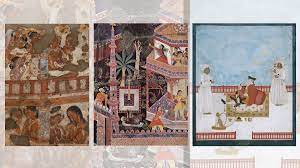India wasn’t richer under Muslim, British rule than it was under Hindu kings

In his blog, Swaminomics, in The Times of India, Swaminathan S Anklesaria Aiyar admonishes those who look back at India’s pre-Islamic past as a golden economic period, asserting instead that India was actually much poorer than other countries on a per capita basis and that we should look to the next few decades as the real golden period in India. In making his arguments, he cites statistics from the famous work by the Organisation for Economic Co-operation and Development economist Angus Maddison, Contours of the World Economy 1–2030 AD: Essays in Macro Economic History.
Below are the key points made by Aiyar
As of 1 CE, India’s per capita income was half that of Italy and even slightly lower than the world average (32 per cent of the world’s GDP vs 33.2 per cent of its population)
India’s GDP and per capita income stagnated from 1 CE to 1000 CE at $33.75 billion and $450 per annum, respectively
Under Muslim rule between 1000 and 1700 CE, GDP tripled to almost $90.7 billion, while per capita income improved slightly to $550 per annum
During the British period between 1700 and 1950, annual GDP rose to $222.2 billion and per capita income to $619
Aiyar cites these numbers to conclude that it was the Hindu period that was one of stagnation while both Islamic and British colonial periods were eras of relative growth and that both these eras were left in the dust by our growth since Independence. India actually wasn’t made poorer by the British, it was left behind by the pace of European growth driven by the industrial revolution.
While Europe certainly benefited greatly from the industrial revolution, Aiyar misleads readers about India’s history by selectively citing statistics without relevant context. In my view, the flaw in Aiyar’s thesis is that he is simply comparing India over millennia with little to no global context. When compared over 2000 years, and in blocks of several centuries, any country will tend to get better with time, in terms of mortality rates and economic performance as civilisation in general advances. A more reasonable analysis requires a comparison against other countries during each time period. I focus my analysis on per capita GDP since that is what Aiyar uses. My source is the same as Aiyar, specifically Table A.7 titled “World per Capita GDP: 20 Countries and Regional Averages, 1–2003AD (1990 international $)”. Let us take each of Aiyar’s assertions in turn.
Also Read: ‘Indians never invaded’ is a myth. Guptas, Cholas, Lalitaditya Muktapida were conquerors
Assessing the Hindu period
In the year 1 CE, India’s per capita income was $450 while Italy’s was indeed almost double at $809. What Aiyar leaves out is context. Most of Western Europe, and virtually all of the rest of the world, is actually in the $400-450 range (France and Spain are slightly higher at $473 and $498, and the world average was $467). The whole world was broadly equal in terms of per capita income. Italy, the example Aiyar chooses, was an exception. Why was that? Italy, in 1 CE, was the centre of a massive empire that drained resources from vast regions, including parts of Western Europe, the Balkans, Eastern Europe, the Middle East and much of North Africa from Egypt to Morocco. India thankfully was never a colonising nation. Notice what happened to Italy by 1000 CE. After the Roman Empire collapsed, it declined right down to $450, exactly where India stood in 1000 CE, again conveniently omitted by Aiyar.
As for his second claim, Aiyar pooh-poohs India’s history by citing that per capita income stagnated for 1000 years during the Hindu-ruled period. What Aiyar leaves out is that European per capita GDP declined by a whopping 29 per cent during this millennium. In comparison, India and China, which remained flat, outperformed Europe dramatically. The only part of the world to show some increase in per capita GDP during this millennium is West Asia by about 19 per cent, because of Islamic colonial loot that accumulated in this region starting in the 7th century (including from the Northwestern parts of India).
Summing up the Hindu period, it is true that India did not have a per capita income that was enormously higher than other countries. But that is not what was implied by “sone ki chidiya” or golden bird. India back then was the land that exported luxury goods — spices, ivory, pearls, perfumes and high-quality textiles — highly sought-after across the world. India wanted to be paid only in gold. In 77 CE, Pliny the Elder, a Roman senator complained that the fondness of Roman women for luxury goods from India and called India “the sink of the world’s gold”. Hence the phrase “sone ki chidiya”. It was first coined by Romans with later references in the Arabian Nights as well. Gold was also seen as auspicious in Hindu culture. Prosperity is always relative, and when the country with the world’s largest GDP (India) also remains flat over a millennium during which Europe declined by 29 per cent, “sone ki chidiya” does assume a larger meaning.
In addition, we are all well aware of the massive temples built by the Cholas in the south (temples in the North largely did not survive Islamic conquests) as well as international universities such as Takshashila, Nalanda, Vikramashila, Odantapuri etc that flourished in North India and attracted students from numerous countries. India led the world at that time in math and science as well. These are clear evidence of the nature and economic might of Indian society during the first millennium. Historian AL Basham’s book The Wonder That Was India, chronicles this period of history.
















